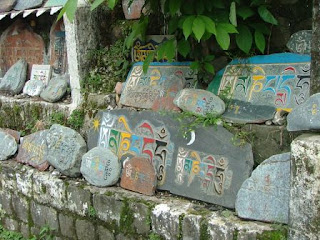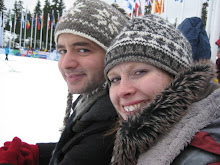Tuesday 3:15 am: Wake up, get ready for bus journey back to Manali. Excited to leave Kaza, there is no electricity here so it has been a long time without a shower.
4:00 am: Arrive at bus station, it is raining very hard out, and has been for a day. A man sells us his tickets because he doesn't want to travel in this weather. There is no way they will let the bus go if the weather is really that bad, right?
4:30 am: Bus departs Kaza. Our spirits are high, we have front seats so it is not nearly as bumpy as our journey to Kaza. With luck we will be in Manali by 2:30 pm, and won't even have bruised bottoms!
7:00 am: Depart Spiti valley and start accent of the first mountain pass, Kunzum elevation 15,000 feet
8:00 am: Snowing pretty hard on Kunzum, bus is making it though, we'll be over soon!
8:30 am: Bus becomes completly stuck in mud and sludge on the top of the pass
9:00 am: Enthusiastic local passengers begin to dig out the bus with signs from the bus that say which town we are going to. There is no shovel in sight, even though this happens every time the bus goes over the pass. The driver is wearing sandels, nobody has a coat
10:00 am: Sure is cold on this bus, blizzard conditions
11:00 am: Second bus arrives from Kaza, it gets stuck next to our bus
12:30 pm: Second bus is pulled out by a tractor, everyone from our bus runs to the second bus, Dan and I are trampeled, I'm pulled onto the bus by helpful fellow foreign travelers. We of course end up in the back of the bus, so much for no bottom bruises.... Our original bus is abandoned.
1:00 pm: Bus slides down the mountain, snow is very deep, road is very skinny, turns are very sharp. If we die this is when it will be. A large bulldozer coming up to clear the pass knocks into our bus, we are teetering on the edge.
2:00 pm: We make it to the bottom of the mountain and celebrate with some lunch at a rest stop




2:30 pm: Continue on the road, we may make it to Manali yet!
3:00 pm: Bus becomes stuck behind a row of jeeps and cars, stuck in a mud slide
4:00 pm: We wait on the bus, everyone is trying to dig out the jeeps from the mudslides, meanwhile giant boulders are rolling down the mountainslide, the incessent rain has caused treacherous rock slides
5:00 pm: The bus is still stuck, the local passengers have walked 2 ks ahead to a rest house, the foreign travelers, Dan and I, a Kiwi and two French decide to grab our stuff and abandon the bus. We run through the rock slide, dodging giant boulders while being sucked into the quicksand like mud.
5:30 pm: Make it to the rest house. There are several rooms with beds, but they are occupied by people with "reservations" and we are not let in. We find a small concrete room that already holds a very sad Australian couple who had gotten a flat tire on their motorcycle and were stranded like us.
6:00 pm: We are soaked, it is very cold
7:00 pm: It is getting dark, we aren't going anywhere tonight. Thankfully the rest house has instant noodles. The foreigners huddle together and resign to spending the night in our concrete cell. We try to entertain each other with songs and stories, but it is so cold....
10:00 pm: Time to go to sleep. Dan and I have no sleeping bags. We put on all our clothes, the foreigners share some blankets and we all lay together for body heat. The concrete room is drafty and wet. We are at 12,000 feet, it is raining

car stuck in the mud, blocking our progress

abandoning the bus
Wednesday 5:00 am: We didn't freeze to death, but we didn't sleep either.
8:00 am: The bus has managed to get through the rock and mud slides. We get back on the bus and try again
8:00 am- 12:00 pm: The bus tries to make it through the next stretch of mud. Every 15 minutes we have to stop to clear boulders. Everyone gets out of the bus, the men try to break down the rocks and push them off the road. The women watch for falling boulders and yell when they roll down. Many sections of the road are too thin for the bus, so we build the road by stacking rocks, walk ahead and watch the bus driver skillfully drive the bus over the shaky ground. The bus hasn't gone over the edge yet....
12:30 pm: The bus gets completly stuck in the mud, blocking the road.
1:00 pm: We abandon the bus again, grab our stuff and walk through the rain to the next village, 2 ks ahead
1:30 pm: We arrive at the village to find many stranded travelers, the road ahead is completely blocked by a giant landslide that is totally unpassable by foot, 10 feet of water cover the road, it is very deep and will likely sweep people off the edge. The village is made up of about 6 tents, all filled with stranded travelers. We resign to spending the day there
5:00 pm: We find some blankets to buy and some socks and hats. Everything we have is totally soaked, we are freezing. There are lots of people here though, and food and fire, so other than the cold it isn't that bad.
10:00 pm: We find a small bench to share in one of the tents. We attempt to sleep, but they tent has no walls. Still it is much better than the concrete room. No sleep



Thursday 8:00 am: The rain has stopped
9:00 am: We have met some other American travelers who have been communicating with the leader of a British school group that is also stranded. He has found a satellite phone in a nearby homestead that works by solar power. Once it is sunny he is able to call and have the British government send a bus to the next village, that is 16 ks ahead.
11:00 am: We set off with the British high schoolers and the Americans on the 16 k hike to the next village. Nobody has as much stuff as we do, and much of the hike is up hill at a high altitude. We have to cross landslides, rockslides, mudslides. Thankfully the British are experienced and have guides, who are able to help us out. The Americans help us carry our stuff, but we are going at a fast pace to get the bus
4:00 pm: We arrive at the next village, the bus is there. We are exhausted, but so close to Manali!
6:00 pm: The bus leaves, we only need to get over one more pass, Rohtang elevation 13,000 feet, to get to Manali
8:00 pm: Bus gets stuck in a traffic jam, this pass has just been opened and it is full of trucks trying to get over. Nobody is directing traffic and the jam is totally unorganized but could be easily fixed
9:00 pm: Giant landslide comes down the pass, totally destroying the road. We aren't going anywhere
10:00 pm: We are to spend the night on the bus. We have no water, and only stale cookies to eat.













Friday 5:00 am: We wake up, the bus is cold, but it is better than concrete or skinny bench. The road is still destroyed
6:00 am: The foreigners on the bus, other than the British school group, decide to take our stuff and walk down the mountain pass. We find short cuts down the rock faced mountain, making it by far the easiest of all our walks. And it was downhill! We couldn't wait for the pass to open
8:00 am: We arrive at the next village, 1000 feet down. We are able to get a taxi to Manali
9:00 am: Taxi leaves the village, we pass hundreds of cars coming up the pass. Nobody has put up a road block or put out any word that the pass is blocked. This entire time there has been no organization or any government involvement in fixing the roads or making sure people were safe. The foreigners were on their own, and thanks to the British Government we had made it out.
12:00 pm: We arrive in Manali, eat a huge breakfast, shower for the first time in 7 days, and fall asleep for the first time in 4.

 The last couple of days of our trip were spent back in Delhi, where we had to catch our plan back to America. We paid a visit to the pleasant National Museum, which among other things had some of the Marwar kingdom art that had inspired the idea of a trip to India in the first place. We also visited the nearby Gandhi memorial, the house where he was assassinated that has been turned into a museum. There are footsteps retracing his last steps until the spot where he was actually shot by a Hindu fanatic. This area of the city was quite a contrast from the older sections we had spent time in: wide, well-paved streets, real sidewalks, the sounds of birds and rustling trees, and a complete lack of people harrassing us. It was close to the government buildings, with many high fences and armed guards.
The last couple of days of our trip were spent back in Delhi, where we had to catch our plan back to America. We paid a visit to the pleasant National Museum, which among other things had some of the Marwar kingdom art that had inspired the idea of a trip to India in the first place. We also visited the nearby Gandhi memorial, the house where he was assassinated that has been turned into a museum. There are footsteps retracing his last steps until the spot where he was actually shot by a Hindu fanatic. This area of the city was quite a contrast from the older sections we had spent time in: wide, well-paved streets, real sidewalks, the sounds of birds and rustling trees, and a complete lack of people harrassing us. It was close to the government buildings, with many high fences and armed guards.




























































